|

When you learn how to play a
new strategy game, it often happens that you feel lost amidst the
many possibilities. Don't let this discourage you. Give yourself
a fair chance and after a few games you will notice that your play
improves rapidly. Below you'll find a few tips to get you started.
To have an optimal effect, we advise you to read them after you
have played your first game, and once again a couple of games later.
Ten Tips for beginners
1. The most important rule
for beginners is: a
turn always starts with putting a piece on a dot!
By doing so -- and only then moving the pieces already in
play -- you will more quickly recognize the possible movements of
the pieces on the board.
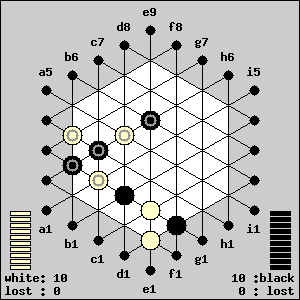 Example Example
If you are playing white and want to play e1-e4 on the e-diagonal,
then don't put the new piece straight on e4. First put it on dot
e1, next move the pieces on e3 and e2 one spot (one by one!), and
next push the new piece onto e2. This is a habit you must get used
to. It may seem like a detail, but it isn't. It helps understanding
how pieces move across the board - and the best way to avoid that
you forget to move the GIPF-pieces. (This is obligatory during tournaments,
too.)
2. There is no side of the
board which you can consider as your side. Make use of the possibility
to attack your opponent from all sides - and, of course, be conscious
(and cautious!) of the fact that your opponent will do the same.
3. When making a move on one
side of the board, always look at what the consequences will be
on the other side, too. If you don't, you will be confronted with
unpleasant surprises…
4. Playing GIPF starts with
the notion that pieces in the play area are more dangerous and effective
than pieces in reserve. Always try to keep as many pieces on the
board as possible.
5. Make use of the possibility
to force your opponent to remove his own pieces (of course, if possible
without losing a piece yourself). That way you weaken his position
in the play area, which often creates better possibilities to attack
his pieces that are still on the board.
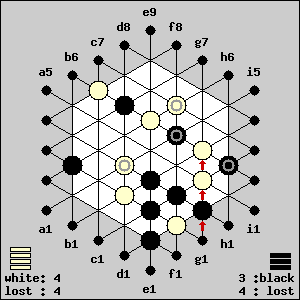 Example Example
Black established a double threat: he's attacking the GIPF-piece
on d4 and the single piece on e6. If White puts a piece on dot g1
and pushes it into the game as indicated by the arrows, he forms
a black row in the c1-i3 line. Black must remove 3 pieces and both
attacks are neutralised.
6. Keep in mind that taking
pieces from the board implies that a number of occupied spots will
no longer be occupied. This often causes new (and dangerous) openings.
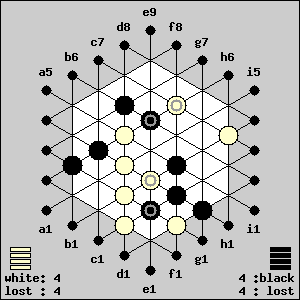 Example Example
White formed a row on the d-line and captures
1 black piece. But after having removed the row, spot d5 will be
vacant again… Black will introduce a piece coming from dot a2 and
capture the white GIPF-piece on f6.
7. In the beginning of a game
you should not bother too much about either your own reserve, nor
your opponent's. The more pieces that are captured, the more important
it becomes to keep a close eye on how many piece you and your opponent
have each left in reserve. You'll notice that often the difference
between winning and losing depends on having just one more piece
in reserve than your opponent (which not always reflects how many
pieces you captured and lost).
8. Don't play with too many
GIPF-pieces. 3 or 4 GIPF-pieces are a good number to start with.
Introducing more GIPF-pieces gives you more attacking power, but
it also means that you have less piecers in your reserve.
9. The center of the board
is important. Just a few GIPF-pieces on the central spots can be
very powerful. But be careful: having pieces in the center often
also means that they can be attacked from all sides -- especially
after having made a capture, because that may implay that you lost
part of your defence.
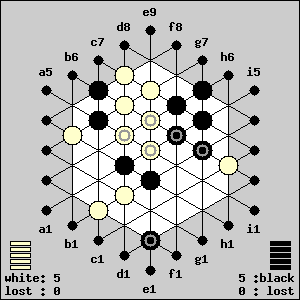 Example Example
The 3 white GIPF-pieces in the center are strong, but fragile too.
White has 2 possible captures, one on the d-line and the other on
the e-diagonal. But… if White would decide to capture with his next
move, he might be facing serious problems soon. Especially since
the cluster of black pieces at the right will become dangerous in
no time. So, White should think about his defense and forget about
capturing right now.
10. Don't be afraid to remove
one of your GIPF-pieces from the board yourself. When you are a
few pieces behind, it is easier for your opponent to make you run
out of pieces than to capture your last GIPF-pieces. In particular
in the final stage removing a GIPF-piece is a way to get more pieces
back into your reserve.
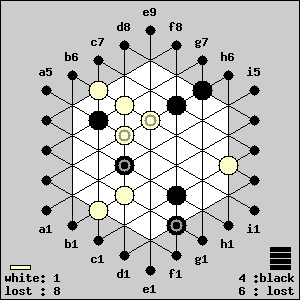 Example Example
White has only one piece
left. He can recycle pieces on the b6-i2 line - and must take his
own GIPF-piece, too. If he does so, he recycles 5 pieces and, even
though he's 2 pieces behind, can try to make Black run out of pieces.
If he doesn't, he only gets 3 pieces back into his reserve, meaning
that Black still holds the last move…
|
 Example
Example Example
Example Example
Example
 Example
Example Example
Example